
图1 酯交换示意图
Fig.1 Schematic diagram of ester exchange
摘要 传统环氧树脂作为干式变压器、电压互感器和复合绝缘子等电工装备的主要原材料,有着良好的力学性能和电学性能,但是其固化后形成的交联网络难溶难熔。随着环氧树脂基电工装备运行年限的增长,大量退役设备的处理面临巨大的挑战。该文制备了基于酯交换的酸酐固化类玻璃化环氧树脂材料(Vitrimers),系统地研究了催化剂对树脂力学、电学、热学以及动态交换性能的影响规律,并使用醇类溶液探索其降解性能。研究结果显示,与传统环氧树脂相比,Vitrimers体系的断裂伸长率较高,表现出良好的韧性。在Vitrimers体系中以1,5,7-三叠氮双环(4.4.0)癸-5-烯(TBD)为催化剂的Vitrimers具有较佳的综合特性,在高温下表现出良好的应力弛豫特性,且能够在7 h(190℃)全部溶解于乙二醇(EG)溶液中。该文研究结果表明,类玻璃化环氧树脂有较综合的力-热-电特性,能够快速溶解于降解溶液,有望用作电工装备的新型环保树脂基体。
关键词:类玻璃化环氧树脂材料 环氧树脂 催化剂 降解 电工装备
环氧树脂固化后能够形成高度交联的三维网状结构,具有尺寸稳定、不易开裂、电绝缘性能及力学性能优良等优点,因此其作为基体树脂被广泛应用于干式变压器、电压互感器及复合绝缘子等电工装备领域[1-3]。但环氧树脂固化后形成的三维交联结构不可逆,这导致其降解、回收和再加工极为困难。随着环氧树脂基电工装备用量的逐渐增大以及运行年限的增加,大量环氧树脂基电工装备即将退役。目前,对于环氧树脂制品的处理方法主要分为两种:①物理回收,对环氧树脂基复合材料进行机械粉碎,将获得的纤维粉末和树脂颗粒用于复合材料的重新制造或者降级使用[4-6];②热回收,使环氧树脂在高温、酸性或者超临界环境中发生裂解,有机物质被分解为气体,从而实现纤维的分离[7-9]。然而,这两种方法均存在很大问题:物理回收方法虽然工艺简单,能量损耗小,但是回收后的纤维粉末和树脂颗粒实用性和有效性较低,回收产品性能差;热回收则会产生大量的有害物质,严重污染环境,且能量损耗大,不符合我国可持续发展的战略目标。综上所述,开发新型绿色可降解的高性能环氧树脂材料成为电工装备领域的研究重点。
为了解决上述问题,类玻璃化环氧树脂材料(Vitrimers)的开发应用成为近年来的研究热点。2011年,L. Leibler团队以醋酸锌和乙酰丙酮锌作为催化剂,催化双酚A二缩水甘油醚和脂肪族二酸进行反应,得到了含有大量动态交换酯键的固化物,并将其命名为Vitrimers[10-12]。Vitrimers是除热固性材料和热塑性材料之外的第三类聚合物材料,这种新的聚合物在低温下具有热固性材料所特有的三维交联网络,在高温下交联网络中的动态键被激活,能够在不改变交联密度的前提下通过交换反应改变聚合物的拓扑结构,实现聚合物交联网络的重塑和解聚。在L. Leibler团队提出基于酯交换的Vitrimers材料后,研究学者们又开发了基于双硫键交换[13-17]、氨基交换[18-19]、烯烃复分解[20-21]和动态亚胺键[22-24]的Vitrimers材料。众多学者虽然开发了除酯交换之外的多种动态共价键,丰富了Vitrimers体系,但是这些动态键的引入大多需要特殊的官能团,制备工艺复杂且成本较高,因此对类玻璃化环氧树脂的研究仍集中在酯交换上。
酯交换反应是酯与醇在酸或碱的催化下生成新酯和新醇的过程。Vitrimers材料中的酯交换过程如图1a所示。在这种羟基和酯键组成的交联网络中,酯交换过程主要涉及两个反应中心:—C=O和—OH。图1b显示了在催化剂作用下酯键和羟基之间的交换反应:羟基负离子对酯键上羰基的亲核攻击导致了四面体结构中间体的形成,该中间体又会解离成新的羟基和酯键。Virtimers材料中酯键和羟基之间的酯交换过程,使得聚合物中三维交联结构的解聚成为可能。Yu Kai等以乙二醇(Ethylene Glycol, EG)作为回收溶液,在高温下激活三维交联网络中酯键和外来羟基之间的酯交换反应,实现了交联结构解聚[25]。此外,Mu Quanyi等对比了乙二醇和丙二醇两种高沸点醇类溶液降解类玻璃高分子的效率,并使用二甲基亚砜(Dimethyl Sulf-oxide, DMSO)、N-甲基吡咯烷酮(N-Methyl-pyrrolidone, NMP)和二甲基甲酰胺(Dimethyl-formamide, DMF)等溶剂辅助降解类玻璃高分子[26]。类玻璃高分子引入了能够热活化的动态交换键,使高度交联的树脂固化物发生降解,为新型绿色电工装备的基体材料设计提供了新的策略。

图1 酯交换示意图
Fig.1 Schematic diagram of ester exchange
大部分基于酯交换的类玻璃化环氧树脂都是在酸酐或者羧酸固化环氧树脂的基础上制备的,该体系制备的关键在于催化剂的加入[27]。一方面,催化剂起着加快交联反应的促进作用,尤其对于酸酐固化环氧树脂来说,催化剂是引发酸酐开环和环氧基发生聚合的关键;另一方面,在一定温度下催化剂催化酯键的可逆反应,赋予类玻璃化环氧树脂动态交换性能。除了醋酸锌和乙酰丙酮锌可作为Vitrimers材料的催化剂外,一些其他类型的催化剂也被开发利用,例如三乙醇胺(Triethanol-amine, TEOA)[28]、1,5,7-三叠氮双环(4.4.0)癸-5-烯(TBD)[29]及锡盐[30]。此外,L. Leibler团队研究了催化剂种类和催化剂含量对材料性能的影响,通过增加催化剂乙酰丙酮锌的含量发现材料的应力松弛时间逐渐下降,拓扑冻结转变温度降低[31]。他们选择三苯基膦(PPh3)、TBD和醋酸锌(Zn(OAC)2)三种不同的催化剂对比发现,TBD和Zn(OAC)2的催化效果优于PPh3,在高温下应力松弛时间更短。S. Bhusal等[32]使用液相实验研究TBD、Zn(OAC)2、1-甲基咪唑(1-MI)和二丁基氧化锡(Dibutyltin Oxide, DBTO)的催化效率。结果表明,四种催化剂的催化效率遵循TBD>DBTO>Zn(OAC)2> 1-MI。目前已开展的研究工作主要针对不同催化剂催化的Vitrimers材料的动态键交换性能、力学性能和热学性能,缺乏对Vitrimers材料电学性能的研究,这严重限制了Vitrimers材料在电工装备领域的应用和发展。
本文主要针对电工装备领域中对环氧树脂及复合材料的应用需求,以在工业界应用最为广泛的双酚A二缩水甘油醚(Bisphenol A Diglycidyl Ether, DGEBA)作为基体树脂,甲基六氢邻苯二甲酸酐(Methylhexahydrophthalic Anhydride, MHHPA)为固化剂,选用四种常见的酯交换催化剂,制备了基于酯交换反应的类玻璃化环氧树脂,系统地研究了不同催化剂构成的类玻璃化环氧树脂的力学性能、电气性能、热性能,并使用乙二醇对不同树脂体系进行降解,探究了不同类玻璃化环氧树脂体系的降解速率。
本文制备试样所使用的主要材料为:双酚A型环氧树脂(E51),环氧摩尔质量平均值为180 g/mol,化学纯,上海树脂厂;甲基六氢邻苯二甲酸酐(MHHPA),纯度≥98%,阿拉丁试剂(上海)有限公司;催化剂2,4,6-三(二甲氨基甲基)苯酚(DMP-30),纯度≥96%,阿拉丁试剂(上海)有限公司;1,5,7-三叠氮双环(4.4.0)癸-5-烯(TBD),纯度≥98%,阿拉丁试剂(上海)有限公司;三乙醇胺(TEOA),纯度≥98%,阿拉丁试剂(上海)有限公司;异辛酸亚锡(Stannous Isooctanoate, Sn(Oct)2),纯度≥98%,阿拉丁试剂(上海)有限公司;乙酰丙酮锌(Zinc Acetylacetonate, Zn(acac)2),纯度≥98%,阿拉丁试剂(上海)有限公司;乙二醇(EG),纯度≥98%,阿拉丁试剂(上海)有限公司;N-甲基吡咯烷酮(NMP),纯度≥98%,阿拉丁试剂(上海)有限公司。
1)传统环氧树脂体系的样品制备:按照文献[33]所使用的配比和制备工艺制备传统环氧树脂。
2)Vitrimers体系的样品制备:环氧基、固化剂和催化剂的摩尔比为1:1:0.05。首先将催化剂加入树脂基体中,在90℃下混合均匀,然后加入固化剂充分搅拌至混合均匀,再将混合物移至真空干燥箱中脱泡10 min,迅速将混合物倒入事先准备好的模具中。TBD、TEOA和Sn(Oct)2三种催化剂都可以在90℃溶于树脂基体,但是Zn(acac)2与树脂相容性差,需要将树脂加热到140℃后再把Zn(acac)2加入树脂基体中混合均匀,当温度冷却至90℃时再加入固化剂充分搅拌至混合均匀,将混合溶液脱泡后倒入事先准备好的模具中进行固化,固化温度由差示扫描量热(Differential Scanning Calorimetry, DSC)曲线确定。不同催化剂的结构式如图2所示。T-DMP、V-TBD、V-TEOA、V-Sn、V-Zn分别代表使用DMP-30、TBD、TEOA、Sn(Oct)2和Zn(acac)2为催化剂制备的树脂。
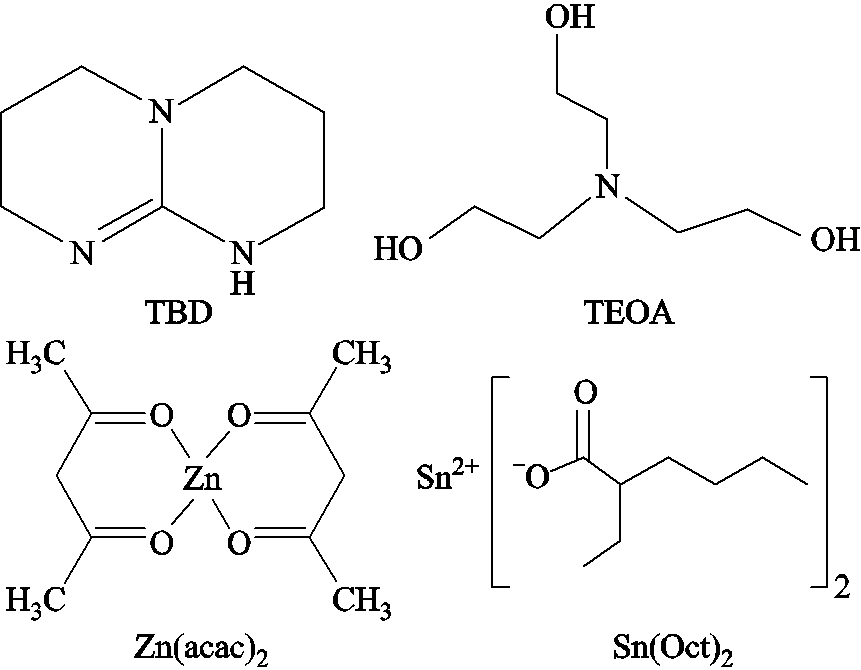
图2 不同催化剂的结构式
Fig.2 Structural formula of different catalysts
1.3.1 固化反应分析
使用差示扫描量热仪研究不同Vitrimers材料的固化反应动力学,确定其固化温度。按比例称取树脂、固化剂和催化剂并混合均匀,取5~10 mg混合液放入铝坩埚中。设置升温速率分别为5、10、15、20℃/min,升温范围为25~250℃,保护气为氮气。
使用傅里叶变换红外光谱仪(Fourier Transform Infrared spectrometer, FTIR spectrometer,Bruker Tensor 27)来分析固化反应的过程,测试不同树脂体系在不同固化阶段下的FTIR光谱。固体样品使用KBr压片测试;液体样品使用衰减全反射(Attenuated Total Reflection, ATR)模式测试,测试范围为400~4 000 cm-1。
1.3.2 动态热性能测试
动态热机械分析(Dynamic Mechanical Analysis, DMA):使用动态热机械分析仪(TA Q800)测试样品薄膜的热机械性能。实验使用单悬臂模式,采样频率为10 Hz,振幅为10 μm。温度以10℃/min的速度从室温升高到300℃。
应力松弛测试:使用动态热机械分析仪(TA Q800)测试样品在恒定温度维持某一形变量所需的应力随时间的变化情况。实验使用拉伸模式,样品形变量为1%。
热重分析(Thermogravimetric Analysis, TGA):使用热重分析仪(Rigaku TG/DTA8122)测试样品的热稳定性。将固体样品在氮气气氛下进行升温测试,温度以10℃/min的速率从室温升到800℃。
1.3.3 力学性能测试
根据标准ISO 527—2—2012和ISO 178—2010的要求制备样品,使用万能拉力实验机进行拉伸和弯曲性能测试。
1.3.4 电气性能测试
击穿强度实验:根据GB/T 1408.1—2016的测试标准进行,以1 kV/s的升压速度测量样品在电场作用下的击穿场强,测量温度为室温,测试样品厚度为1 mm,每种样品测试15次以上,利用Weibull分布函数分析不同试样的击穿强度。
介质损耗实验:采用YG9100全自动抗干扰精密介质损耗测试仪(上海杨高电器有限公司),高压西林电桥正接。测试温度为25℃,电压频率为 50 Hz,实验电压为2 kV。
泄漏电流实验:按照标准DL/T 1580—2016的要求,测试样品是直径为60 mm、高度为30 mm的圆柱体。实验开始前将样品放置在两个电极间夹紧,实验电压以2 kV/s的速率上升到12 kV,持续1 min,记录12 kV下试样的泄漏电流。
1.3.5 降解测试
将尺寸为40 mm×10 mm×4 mm的长方体块浸泡在装有乙二醇(EG)溶液的烧杯中。将玻璃烧杯在190℃下油浴加热,使用冷凝管对溶剂进行回流。每小时将树脂样品从溶液中取出称重,观察不同树脂体系的质量变化。
环氧树脂的固化反应动力学分析对于环氧树脂在实际应用过程中的制备工艺参数具有极大意义。本文使用非等温差示扫描量热法研究基于酯交换的Vitrimers材料的固化反应动力学。Vitrimers材料在四种不同升温速率下的热流变化曲线如附图1所示。环氧树脂E-51/固化剂MHHPA固化反应中只包含单一放热峰,随着升温速率的提高,热流曲线峰值的温度右移,峰值提高,且峰的宽幅变窄,放热更加集中。随着升温速率的提高,固化反应中的初始固化温度Ti、峰值固化温度Tp、终止固化温度Te也逐渐升高。附表1为不同升温速率下有关固化特性的所有参数。对不同升温速率下的Ti、Tp和Te进行线性拟合,可以确定不同Vitrimers体系的固化工艺。根据线性拟合可知,T-DMP、V-TBD、V-TEOA和V-Zn的各固化阶段温度相近,确定其固化工艺为110℃/2 h+130℃/2 h+150℃/3 h。V-Sn的峰值固化温度和终止固化温度较高,同时为了防止固化温度太高导致树脂分解,确定其固化工艺为110℃/2 h+ 150℃/2 h+180℃/3 h。
不同树脂体系在20℃/min下的固化反应曲线如图3所示。由于不同Vitrimers体系中环氧树脂/酸酐的比例恒定,因此催化剂是导致DSC数据差异的根本原因。由图3可知,V-TBD的初始固化温度相对较低,且放热峰峰值更高,这说明TBD提高交联反应活性和降低固化温度的能力更加显著。此外,V-TBD和T-DMP对应的固化放热峰温度相近,明显低于其他Vitrimers材料。V-Sn中固化反应的起始温度较高,且固化发生在150~300℃的较宽温度范围内,催化效率较低。
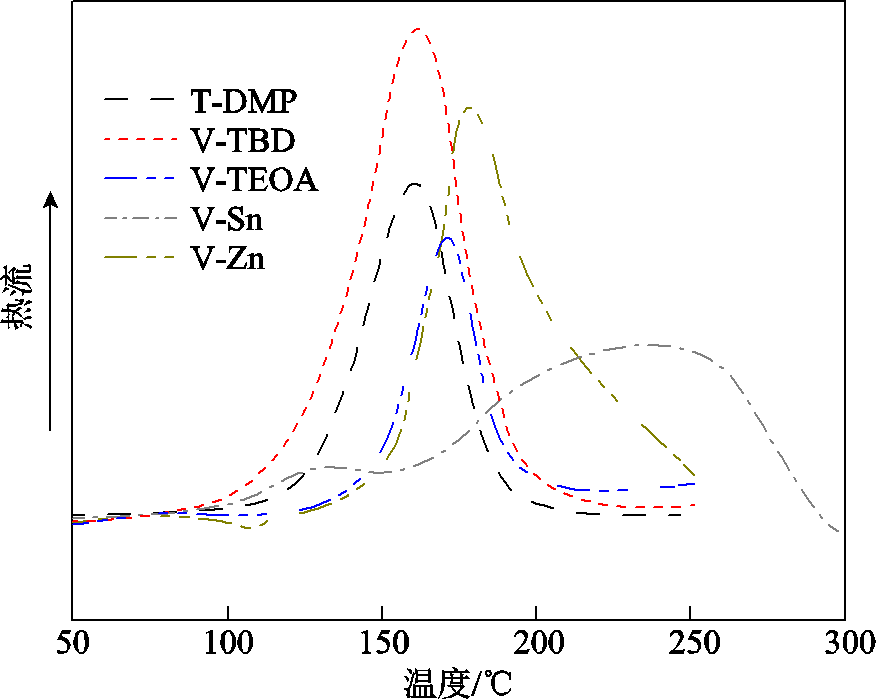
图3 不同树脂体系在20℃/min下的固化反应曲线
Fig.3 Curing reaction curves of different resin systems at 20℃/min
不同树脂体系在不同固化阶段的FTIR光谱如图4所示。未加热固化前的树脂混合物中910 cm-1处环氧基团和1 850 cm-1处酸酐基团的特征峰峰值明显。经过不同阶段的固化后,树脂中910 cm-1处的环氧基团特征峰在5个树脂体系中均消失,3 500 cm-1处的自由羟基出现明显峰值,酯键对应1 750~1 735 cm-1的C=O区域和1 210~1 163 cm-1的C—C(=O)—O区域出现强吸收峰,说明DGEBA中环氧基团已打开并与固化剂发生交联反应,形成以酯键为基础的交联网络,为酯交换反应的触发奠定基础。此外,图4e显示,V-Sn经过110℃/2 h的固化后,树脂的FTIR光谱中仍然存在明显的环氧基团和酸酐基团特征峰,经过150℃/2 h和180℃/3 h的固化后环氧基团和酸酐基团特征峰才逐渐消失。这说明Sn(Oct)2促进交联反应的能力较弱,与固化反应分析得到的结果一致。
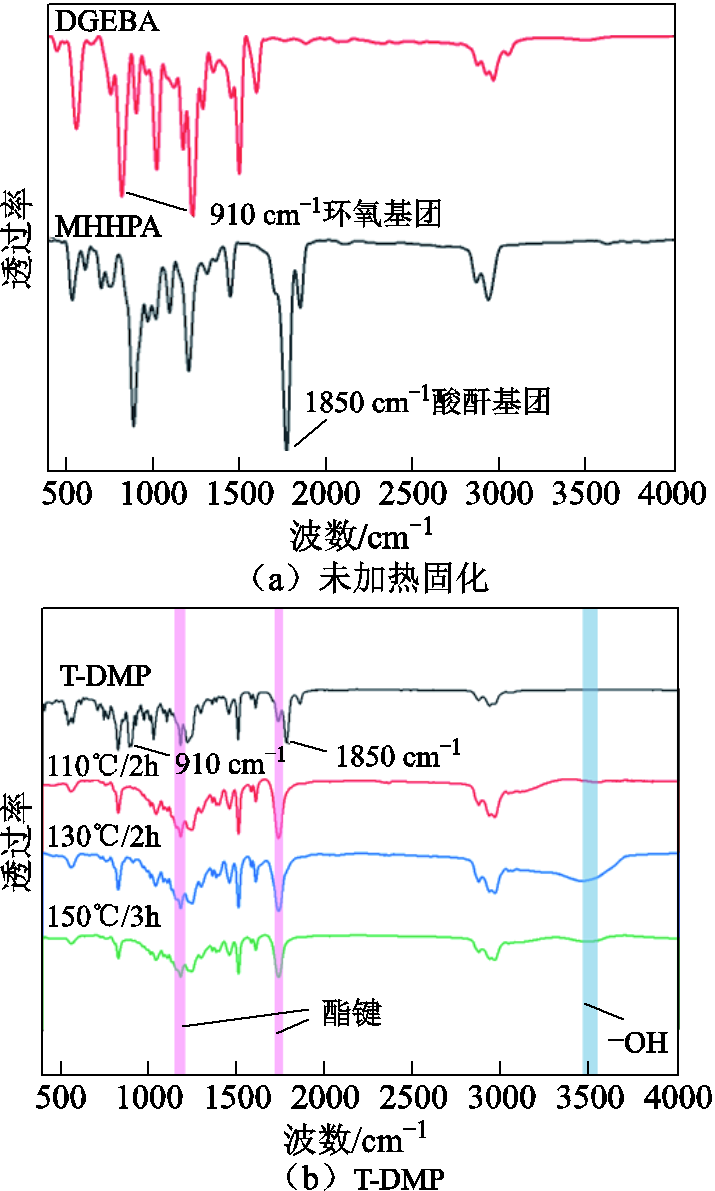

图4 不同树脂体系在不同固化阶段的红外光谱
Fig.4 Infrared spectral curves of different resin systems at different curing stages
动态热性能测试能够得到材料的储能模量E'和损耗因数tanδ随温度变化的曲线,是表征树脂基体黏弹性的重要性能指标之一。不同催化剂构成的Vitrimers材料的储能模量E'和损耗因数tanδ随温度变化的曲线如图5所示。

图5 不同树脂体系的动态热机械测试结果
Fig.5 The dynamic thermomechanical test results of different resin systems
根据橡胶弹性理论演变方程,交联密度可以表示为[34]
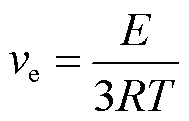 (1)
(1)
式中,ve为交联密度,mol/m3;E为玻璃化转变温度Tg以上的橡胶平台区的储能模量,单位为10-1 Pa;R为普通气体常数,R=8.314 J/(mol·K);T为热力学温度,K。一般E取Tg+40℃对应的储能模量,不同树脂体系的交联密度见表1。不同树脂体系的交联密度依次为V-Zn>V-TBD>T-DMP>V-TEOA>V-Sn。不同催化剂促进交联反应的能力越强,活化能越低,越容易发生交联反应,形成的交联网络密度会越高。对于活化能较高的树脂体系来说,交联反应速率慢,且随着交联反应的发生,交联结构的形成会使得环氧基团和酸酐基团碰撞的概率降低,导致交联密度较低[35]。附图2是根据不同树脂体系的固化曲线使用Kissinger方法计算得到的活化能。V-Zn、V-TBD和T-DMP的活化能较低,更容易发生交联反应,有着较高的交联密度;而V-Sn的活化能最高,且固化发生在150~300℃的较宽温度范围内,交联密度最低。
表1 不同树脂体系的交联密度
Tab.1 Crosslink density of different resin systems

树脂体系 Tg/℃交联密度/(kmol/m3) T-DMP143.5813.4 V-TBD163.8914.2 V-TEOA132.789.4 V-Sn127.136.4 V-Zn158.6518.6
传统环氧树脂与类玻璃高分子的储能模量随着温度的升高逐渐下降,在温度到达Tg以前,固化物处于玻璃态,分子链段运动受限,只存在结构基团的伸缩振动,此时树脂固化物表现为刚性,储能模量较高;而随着温度的不断上升,固化物进入橡胶态,分子链段的运动加强,储能模量随之降低。由图5a可以看出,在温度到达Tg以前,V-Sn的储能模量最高,V-TBD的储能模量最低,这说明V-Sn的分子链段刚性最强。
由图5b可知,T-DMP、V-TBD、V-TEOA、V-Sn和V-Zn的Tg分别为143.58、163.89、132.78、127.13和158.65℃,能够满足环氧树脂基电工装备的运行条件。交联聚合物的Tg受骨架刚度和交联密度的影响,由表1可知,V-TBD和V-Zn的交联密度较高,因此它们具有更高的玻璃化转变温度。
通过TGA测试可以研究材料的热稳定性,良好的热稳定性是电工装备长期可靠运行的重要前提。不同树脂体系的热稳定性测试结果如图6所示,TGA测试的各项参数见表2。表2中,Ta%代表质量损失为a%时的温度,Tmax为失重速率最大时对应的温度。由表2可知,传统树脂体系的初始分解温度T5%=360.02℃,Vitrimers体系的初始分解温度均低于传统树脂体系,这是由于Vitrimers材料中包含动态酯键。在较高温度下,交联网络中的酯交换反应被激活,导致它们的热稳定性下降。此外,V-TBD和V-Zn体系的初始降解温度分别为308.97℃和313.43℃,稳定性次于V-TEOA体系。由表1可知,V-TBD和V-Zn有着较高的交联密度,但是它们的T5%却低于V-TEOA。较高的交联密度和酯交换催化效率使得高温下酯交换反应更加剧烈,导致其热稳定性下降[36]。V-Sn体系的初始分解温度最低,仅为传统树脂体系的63.55%,其稳定性最差,这可能是由于其交联密度太低所致。在分解速率曲线中,V-TEOA与T-DMP体系的分解速率曲线基本重合,失重速率最大时对应的温度相近,稳定性较强。

图6 不同树脂体系的热稳定性测试结果
Fig.6 The thermal stability test results of different resin systems
表2 不同树脂体系的TGA参数
Tab.2 TGA parameters of different resin systems

树脂体系T5%/℃T50%/℃Tmax/℃ T-DMP360.02412.67403.71 V-TBD308.97391.79406.33 V-TEOA342.35405.53408.08 V-Sn228.80370.01367.51 V-Zn313.43387.68385.17
在动态热机械分析仪上采用拉伸模式对不同树脂体系样品的应力松弛性能进行测试。树脂在高温下的应力松弛行为能够反映交联网络中酯交换反应的动态性能,进而得到催化剂种类和温度对酯交换反应速率的影响。图7a为不同树脂体系在210℃下的应力松弛情况。图中δt为t时刻应力值,δ0为初始应力值。所有Vitrimers体系的样品均表现出明显的应力弛豫,相比之下,T-DMP并没有明显的松弛,这反映了催化剂对酯交换过程的必要性。图7b为V-TBD体系在不同温度下的应力松弛情况。在较低温度(180℃)下,由于酯交换反应速率较慢,树脂交联网络基本处于冻结状态,应力松弛速率较慢。当温度升高到210℃和240℃时,酯交换反应速率加快,树脂表现出较强的应力松弛行为,松弛速率显著加快。V-TBD在240℃下的松弛时间仅为12 min(应力衰减到初始值的1/e时对应的时间),远低于180℃和210℃下的松弛时间。上述研究结果表明:和T-DMP相比,Vitrimers材料在高温下能够表现出明显的应力弛豫,且V-TBD的应力松弛速率最快。
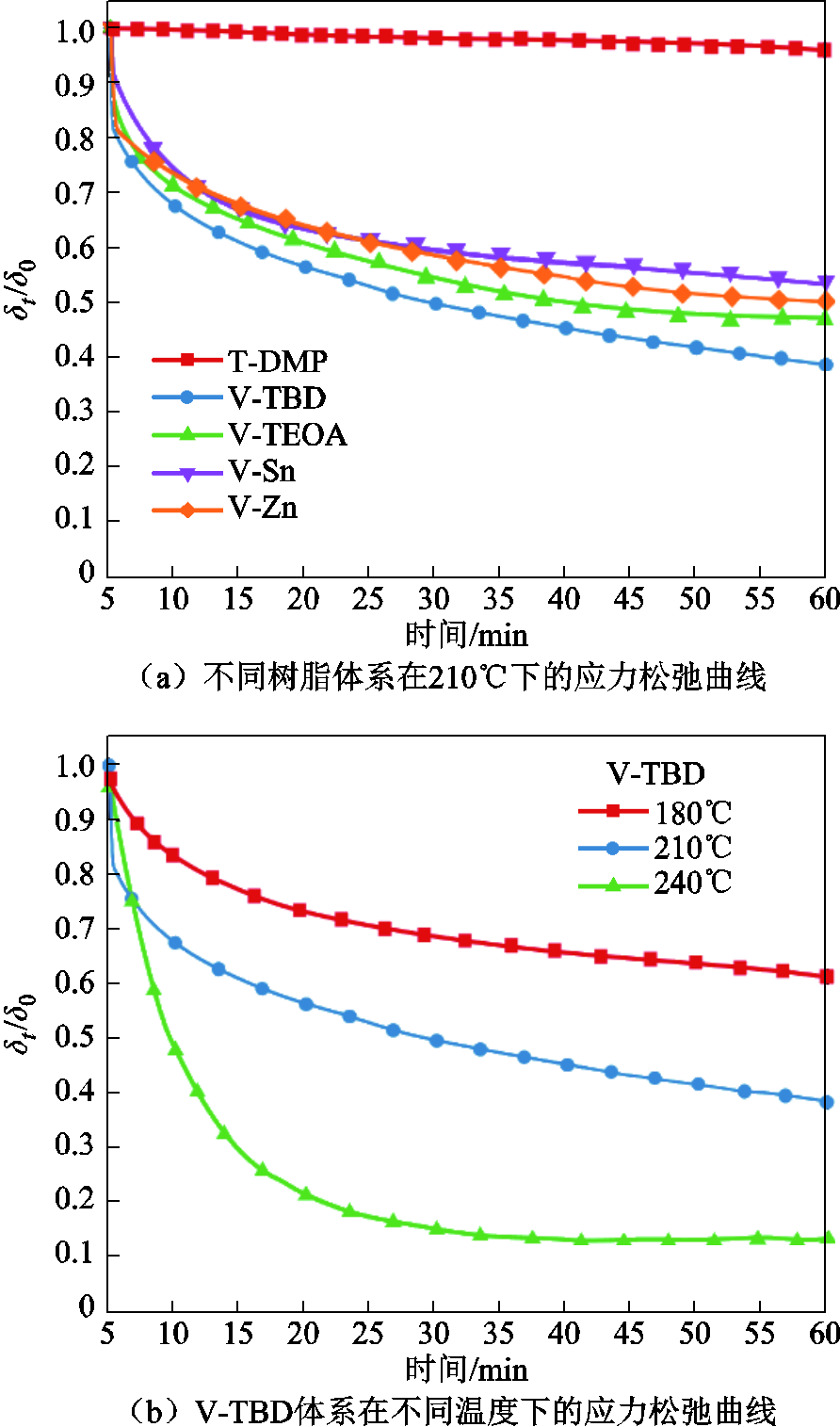
图7 不同树脂体系的应力松弛曲线
Fig.7 Stress relaxation curves of different resin systems
力学特性是环氧树脂应用于电工装备领域的一个重要指标,良好的力学特性能够使得环氧树脂基电工装备具有更长的运行寿命[37-38]。不同催化剂组成的Vitrimers体系的力学性能如图8所示。由图8可知,与T-DMP相比,部分Vitrimers材料的力学性能下降。然而V-TEOA的拉伸强度和弯曲强度与T-DMP相近。V-Zn的力学性能表现最差,其拉伸强度、弯曲强度和断裂伸长率分别为43.50 MPa、 15.39 MPa和6.46%。由于常温下Vitrimers材料不会发生动态酯交换反应,因此力学特性的差异可能是由于交联网络结构引起的。由附图1可知,TBD和Zn(acac)2促进环氧树脂交联反应的效率更高。交联反应的快速发生会大量放热,样品集中放热导致局部固化反应剧烈,从而在交联网络中引入较多缺陷,导致其力学特性较差。
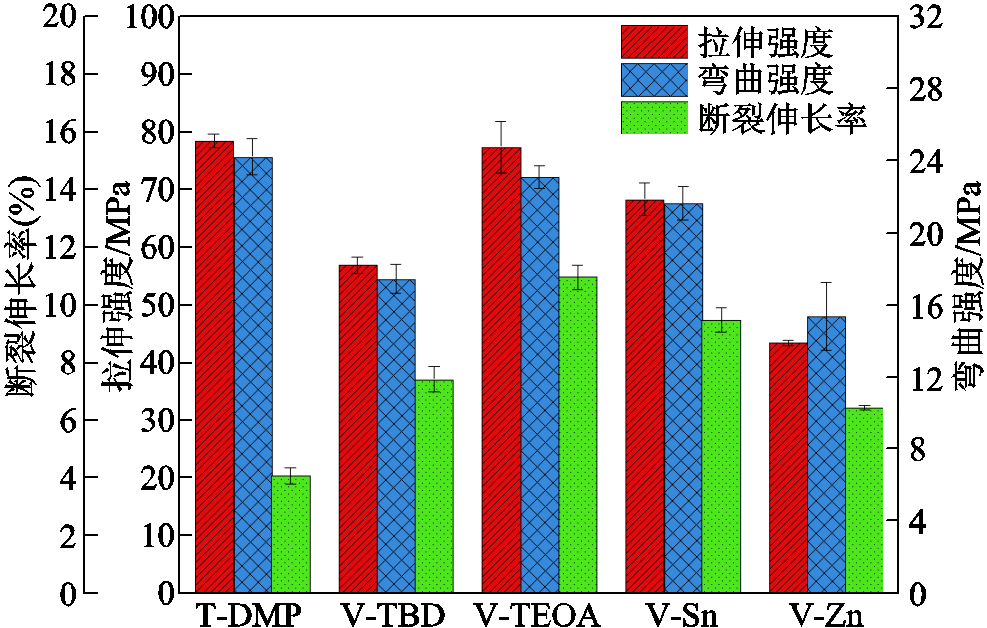
图8 不同树脂体系的力学性能
Fig.8 Mechanical properties of different resin systems
然而,Vitrimers的断裂伸长率明显高于传统树脂体系,表明其较T-DMP具有更好的韧性。这是因为Vitrimers体系中催化剂能够增强分子链段的柔性,使Vitrimers体系的断裂伸长率提高[28],其中V-TEOA体系的断裂伸长率最高,为10.98%。电工装备用环氧树脂体系普遍存在韧性低、内应力大等问题,在运行过程中容易在电动力或振动作用下出现开裂现象。Vitrimers树脂体系韧性提高,有利于提高环氧浇注电气装备的结构稳定性。
击穿强度是绝缘材料极为重要的电气性能指标之一,它反映了材料的耐电强度[39]。图9为传统环氧树脂和Vitrimers体系工频击穿场强的Weibull分布。T-DMP、V-TBD、V-TEOA、V-Sn和V-Zn的击穿场强分别为44.02、41.73、39.16、36.20、37.12 kV/mm。与T-DMP相比,Vitrimers树脂的工频击穿场强均有所下降,动态共价键的弱键性是引起其电气性能下降的主要原因。与传统树脂体系中的共价键不同,Vitrimers材料中的酯键能够在一定温度下发生动态交换反应,温度越高,酯交换反应速率越快。即便是在较低温度下,交联网络中的酯键也会与羟基发生交换反应[40]。由表1可知,与 T-DMP相比,V-TBD和V-Zn有着较高的交联密度。致密的交联网络能够减少载流子的移动,然而Vitrimers材料中的酯交换过程影响交联网络的致密性,同时较高的交联密度导致酯交换反应更容易发生,这使得V-TBD和V-TEOA的电气性能较 T-DMP有所降低[41]。V-TEOA和V-Sn体系的交联密度较低,载流子更容易移动,同时酯交换反应的存在也会导致载流子的移动,使其电气性能下降得更为显著。此外,V-TBD和V-Zn有着比V-Sn和V-TEOA更高的交联密度,V-TBD和V-Zn的击穿强度保持率应该高于V-Sn和V-TEOA。然而V-Zn的击穿强度却低于V-TEOA,这可能是由于V-Sn和V-Zn体系中的金属离子催化剂所致。金属离子催化剂在促进交联反应的过程中会同步产生金属离子,这些游离的金属离子在电场的作用下容易产生较多电子,增强了树脂的导电性,进而导致其击穿强度有所下降[42-43]。

图9 不同树脂体系击穿场强的Weibull分布
Fig.9 The Weibull distributions of different resin systems
泄漏电流和介质损耗因数是检验材料电气性能的重要指标,在环氧树脂基电工装备的性能评估中广泛应用[44-45]。传统环氧树脂和Vitrimers体系的泄漏电流和介质损耗因数如图10所示。T-DMP的泄漏电流和介质损耗因数分别为35.12 μA和0.45%,Vitrimers体系的泄漏电流和介质损耗因数均高于T-DMP,其中V-TBD的泄漏电流和介质损耗因数较低,分别为36.02 μA和0.46%。金属离子催化的Vitrimers体系中由于催化剂中包含的金属离子会增加导电性,导致V-Sn和V-Zn体系有着较高的泄漏电流和介质损耗因数。Vitrimers材料的泄漏电流和介质损耗因数有着与击穿强度类似的规律。
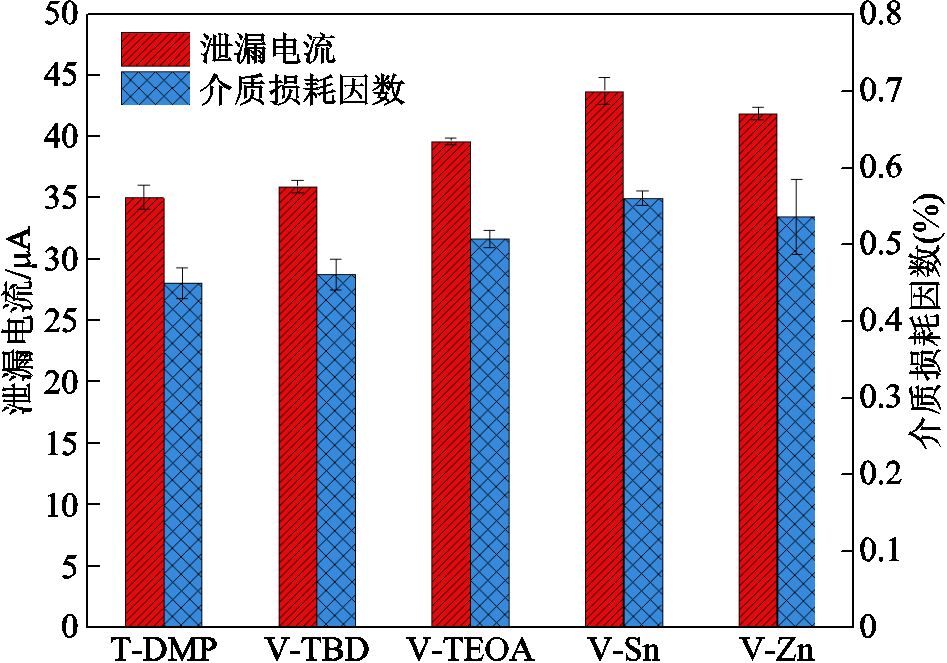
图10 不同树脂体系的泄漏电流和介质损耗因数
Fig.10 The leakage current and dielectric loss factor of different resin systems
综上所述,催化剂的种类对Vitrimers体系的电气性能有较大影响,TEOA和TBD等催化剂构成的Vitrimers体系具有更优的电气性能。
在高温和催化剂的作用下,Vitrimers交联网络中酯键和羟基之间的动态交换反应会被激活。将树脂固化物浸泡在醇类溶液中,在加热条件下利用醇类溶液中羟基与交联网络中酯键的交换反应,能够有效地切断交联结构,从而实现环氧树脂的降解。Vitrimers体系在乙二醇中的溶解过程及原理如图11所示。醇类小分子在高温下以表面侵蚀的模式逐渐侵入交联网络,在树脂和醇类溶液的接触面形成凝胶层,醇类小分子通过凝胶层不断侵入树脂内部。在酯交换催化剂的影响下,醇溶液中的自由羟基和交联网络中的酯键发生动态交换反应,逐渐打开交联结构成为环氧低聚物[46-47]。

图11 Vitrimers树脂在乙二醇中的降解过程及原理
Fig.11 Degradation process and principle of Vitrimers in EG
乙二醇作为用于降解类玻璃化环氧树脂中的最常见的高沸点溶剂,与动态酯键的反应速率较快。在乙二醇溶液中,传统环氧树脂和不同Vitrimers体系的残余质量曲线及外观变化分别如图12和图13所示。传统环氧树脂在乙二醇溶液中基本不溶解,而不同Vitrimers体系的样品能够逐渐溶解在溶液中。在溶解初期,不同树脂体系的样品质量均有一定程度的上升,这是由于溶剂的扩散引起的溶胀效应[48]。在降解溶液中,乙二醇分子逐渐侵入样品内部,而由于Vitrimers体系中动态交换网络的引入,使得乙二醇分子的活性羟基与树脂内部的酯键发生动态交换,逐渐打开树脂的三维交联结构,实现树脂的降解。
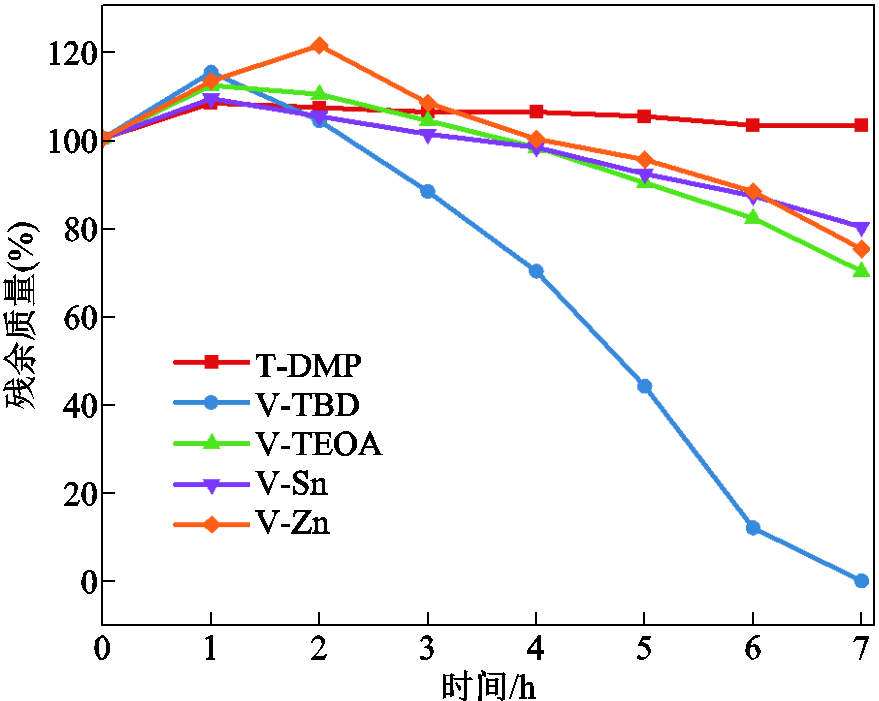
图12 不同树脂体系在乙二醇溶液中的归一化残余质量
Fig.12 The normalized residual mass of different resin systems in EG

图13 不同树脂体系在乙二醇溶液中加热后的外观变化
Fig.13 Appearance of different resin systems after heating in EG
根据不同Vitrimers体系的降解速率可知,使用TBD作为酯交换反应的催化剂时,表现出远高于其他Vitrimers体系的降解速率。一方面,V-TBD的交联密度更大,为酯交换反应提供了更多酯键;另一方面,由于TBD在催化酯交换的过程中表现出双功能催化剂的机制,可以同时发挥酸性和碱性催化剂的作用来降低中间体形成的势垒,能够加快酯交换反应的发生[49-51]。TBD催化剂中的悬氢(酸)和双键氮(碱)是其能够同时发挥酸和碱催化剂效果的关键。酸性和碱性催化剂可以加速酯交换过程。酸性催化剂从羰基的—C上吸收电子,增强羰基的亲电性;碱性催化剂则作为供给电子的基团增强了烷氧基上—O的亲核性。两种方法都能降低形成四面体结构的中间体的势垒,加速新酯和羟基的产生。正是由于催化剂能够促进酯交换反应的发生,才使得材料具有了可降解的特性。TBD中的悬氢发挥酸性催化剂的作用,吸收酯键中羰基的—C的电子,增加羰基碳的亲电性;同时TBD中的双键氮作为碱性催化剂发挥作用,推动电子云向烷氧基移动,增强烷氧基上氧的亲核性。与其他催化剂相比,TBD能够同时增强羰基碳的亲电性和烷氧基上氧的亲核性,推动后续的亲核攻击,因此具有较快的酯交换反应催化速率。
本文使用1,5,7-三叠氮双环(4.4.0)癸-5-烯、三乙醇胺、异辛酸亚锡和乙酰丙酮锌为催化剂,制备了不同的Vitrimers体系,对比分析了传统树脂体系和Vitrimers体系的力学性能、电气性能和热性能,为Vitrimers在电工装备领域的应用提供了一定的理论支撑。得到相关结论如下:
1)与传统环氧树脂相比,Vitrimers体系的弯曲强度和拉伸强度有所下降,但是由于催化剂的催化效果降低了Vitrimers体系分子链段的柔韧性,其断裂伸长率较高,表现出良好的韧性。其中V-TEOA的综合力学特性较优,其拉伸强度为77.33 MPa,弯曲强度为23.08 MPa,断裂伸长率为10.98%。
2)与传统环氧树脂相比,Vitrimers体系的工频击穿强度有所下降,其中金属离子催化剂Sn(Oct)2和Zn(acac)2催化的Vitrimers体系下降最为严重,分别为传统环氧树脂击穿强度的82.24%和84.33%。V-TBD的综合电气性能最优,其工频击穿场强为41.73 kV/mm,泄漏电流为36.02 μA,介质损耗因数为0.46%。
3)与传统环氧树脂相比,Vitrimers体系的热稳定性均低于传统树脂体系。但是V-TEOA体系的T5%与T-DMP相近,为342.35℃,热稳定性较优。此外V-TBD有着最高的玻璃化转变温度,为163.89℃。
4)与传统环氧树脂相比,Vitrimers体系在较高温度下表现出良好的的动态交换性能,其中V-TBD的应力松弛速率最快。
5)在乙二醇溶液中,传统环氧树脂无法溶解,而具有动态键的Vitrimers体系能够实现溶解,其中V-TBD的溶解效果最佳。
综上所述,TBD催化的类玻璃化环氧树脂具有良好的力学性能、电气性能和热性能,能够在乙二醇溶液中溶解,有望作为电工装备领域的基体树脂。
附 录
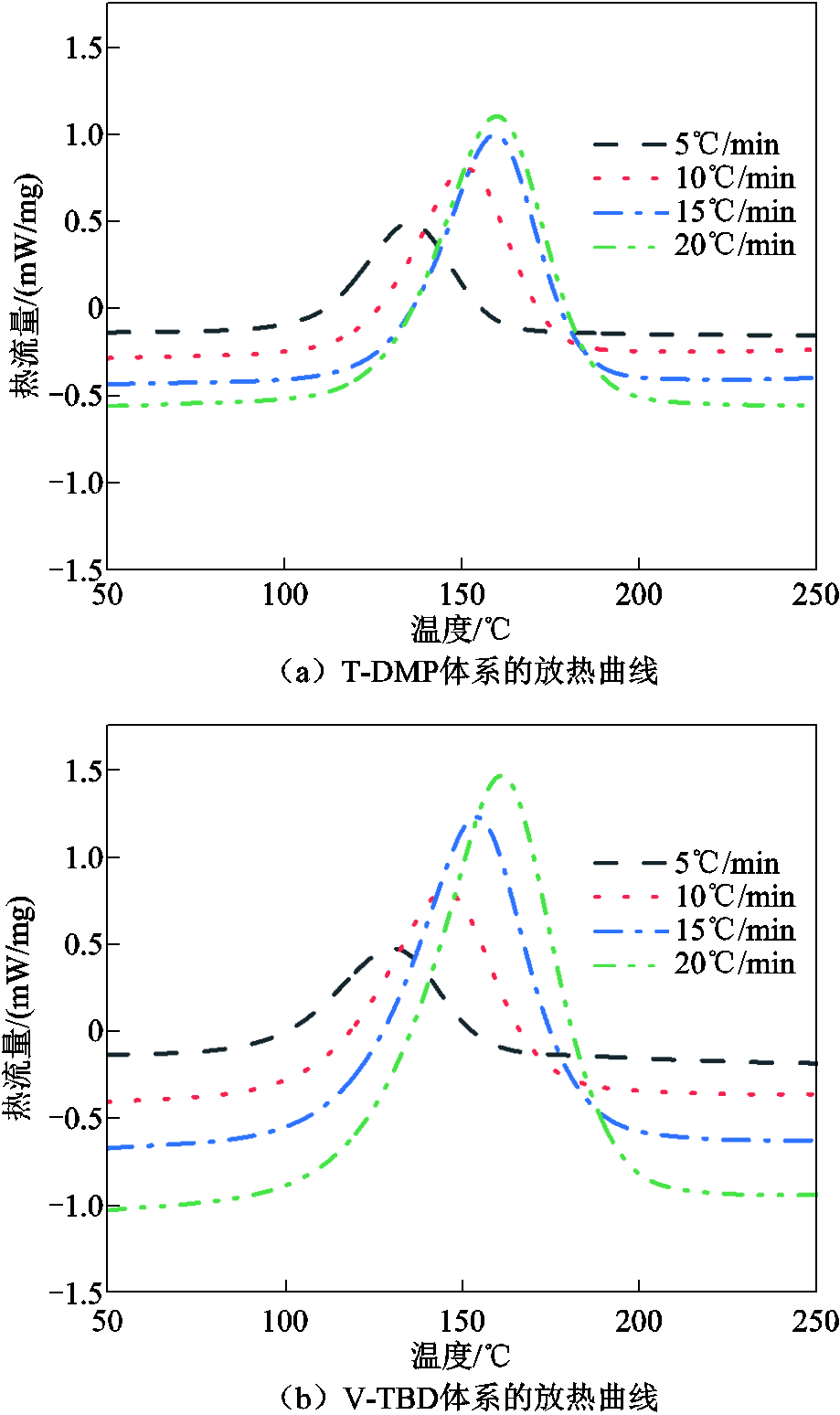
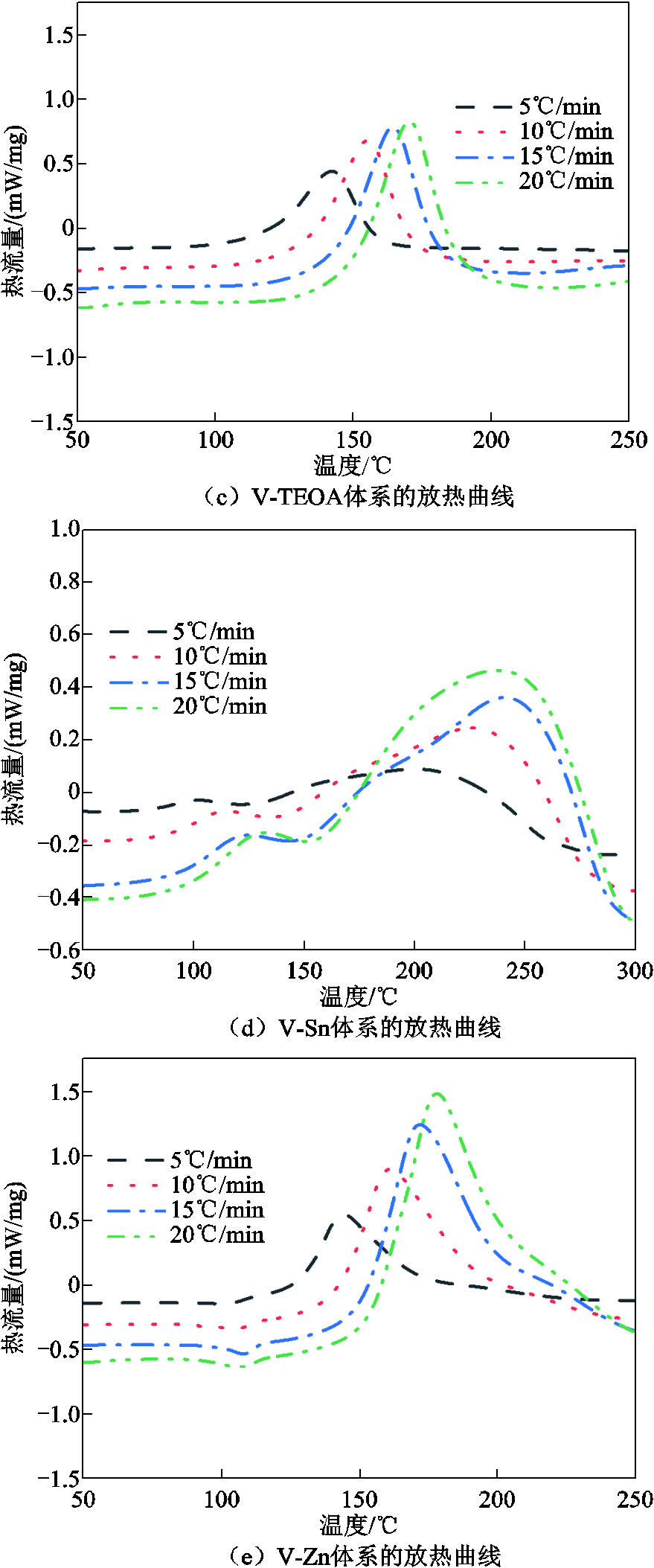
附图1 不同树脂体系的DSC放热曲线
App.Fig.1 DSC exothermic curves of different resin systems
附表1 不同加热速率下树脂体系的固化特性参数
App.Tab.1 Parameters of curing characteristics for different resin systems at different heating rates

树脂体系升温速率/(℃/min)初始固化温度Ti/℃峰值固化温度Tp/℃终止固化温度Te/℃ T-DMP0105.55130.7152.9 5108.6135.1158.5 10122.1150.8175.0 15130.1159.1182.8 20128.2159.6186.2
(续)
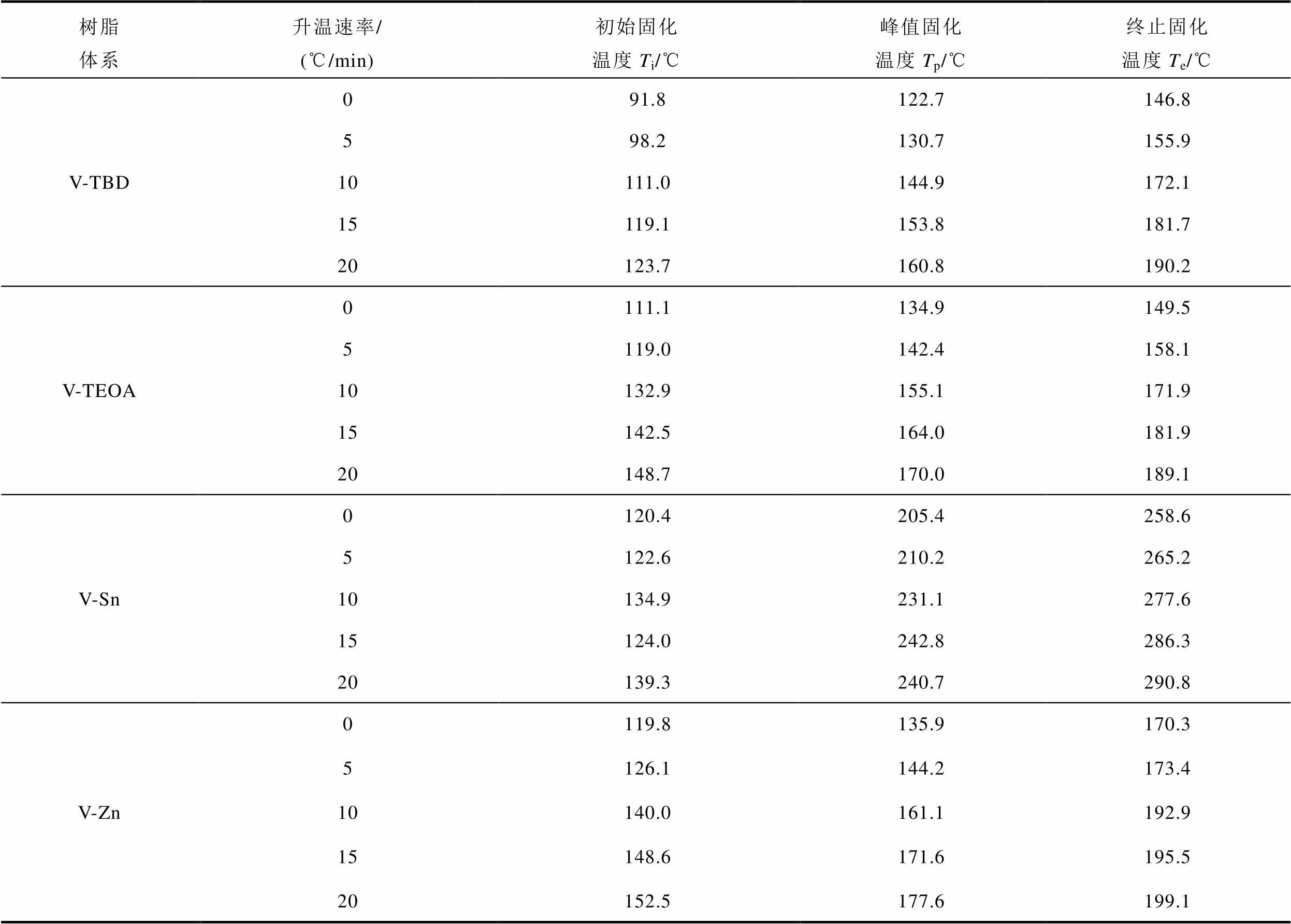
树脂体系升温速率/(℃/min)初始固化温度Ti/℃峰值固化温度Tp/℃终止固化温度Te/℃ V-TBD091.8122.7146.8 598.2130.7155.9 10111.0144.9172.1 15119.1153.8181.7 20123.7160.8190.2 V-TEOA0111.1134.9149.5 5119.0142.4158.1 10132.9155.1171.9 15142.5164.0181.9 20148.7170.0189.1 V-Sn0120.4205.4258.6 5122.6210.2265.2 10134.9231.1277.6 15124.0242.8286.3 20139.3240.7290.8 V-Zn0119.8135.9170.3 5126.1144.2173.4 10140.0161.1192.9 15148.6171.6195.5 20152.5177.6199.1
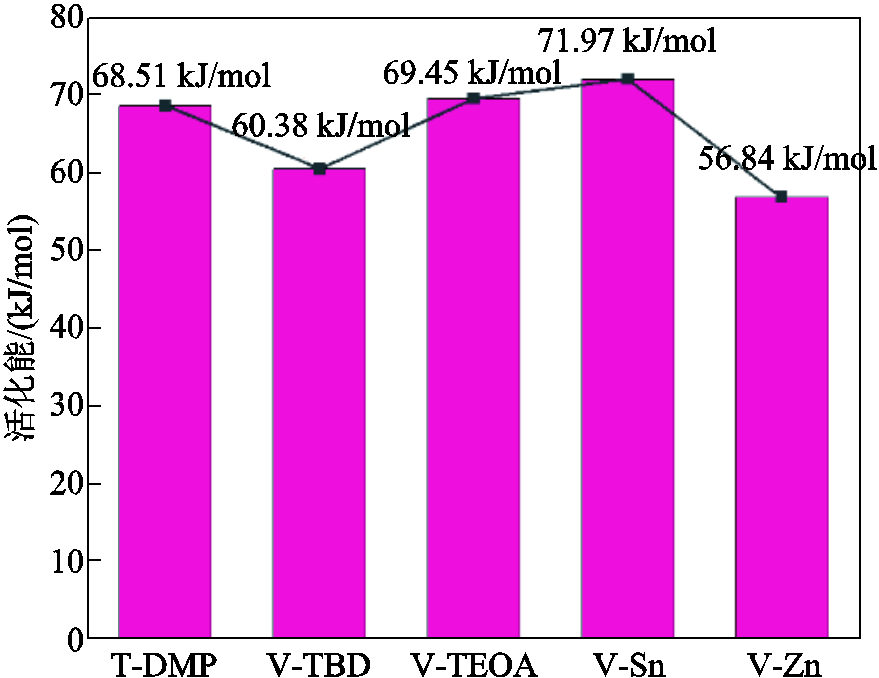
附图2 不同树脂体系的活化能
App.Fig.2 Activation energy of different resin systems
参考文献
[1] 刘贺晨, 孙章林, 刘云鹏, 等. 基于酯交换的可回收类玻璃化环氧树脂制备与性能研究[J].电工技术学报, 2023, 38(15): 4019-4029.
Liu Hechen, Sun Zhanglin, Liu Yunpeng, et al. Preparation and properties of recyclable vitrified epoxy resin based on transesterification[J]. Transactions of China Electrotechnical Society, 2023, 38(15): 4019-4029.
[2] 王有元, 王施又, 黄炎光, 等. 干式变压器环氧树脂热老化特性研究[J]. 高电压技术, 2018, 44(1): 187-194.
Wang Youyuan, Wang Shiyou, Huang Yanguang, et al. Study on thermal aging characteristics of epoxy resin of dry-type transformer[J]. High Voltage Engineering, 2018, 44(1): 187-194.
[3] 关志成, 彭功茂, 王黎明, 等. 复合绝缘子的应用及关键技术研究[J]. 高电压技术, 2011, 37(3): 513-519.
Guan Zhicheng, Peng Gongmao, Wang Liming, et al. Application and key technical study of composite insulators[J]. High Voltage Engineering, 2011, 37(3): 513-519.
[4] Mamanpush S H, Li Hui, Englund K, et al. Extruded fiber-reinforced composites manufactured from recycled wind turbine blade material[J]. Waste and Biomass Valorization, 2020, 11(7): 3853-3862.
[5] Vincent G A, de Bruijn T A, Wijskamp S, et al. Shredding and sieving thermoplastic composite scrap: method development and analyses of the fibre length distributions[J]. Composites Part B: Engineering, 2019, 176: 107197.
[6] Beauson J, Madsen B, Toncelli C, et al. Recycling of shredded composites from wind turbine blades in new thermoset polymer composites[J]. Composites Part A: Applied Science and Manufacturing, 2016, 90: 390-399.
[7] Rahimizadeh A, Tahir M, Fayazbakhsh K, et al. Tensile properties and interfacial shear strength of recycled fibers from wind turbine waste[J]. Composites Part A: Applied Science and Manufacturing, 2020, 131: 105786.
[8] Hao Siqi, He Lizhe, Liu Jiaqi, et al. Recovery of carbon fibre from waste prepreg via microwave pyrolysis[J]. Polymers, 2021, 13(8): 1231.
[9] Meng F, McKechnie J, Turner T A, et al. Energy and environmental assessment and reuse of fluidised bed recycled carbon fibres[J]. Composites Part A: Applied Science and Manufacturing, 2017, 100: 206-214.
[10] Capelot M, Montarnal D, Tournilhac F, et al. Metal-catalyzed transesterification for healing and assembling of thermosets[J]. Journal of the American Chemical Society, 2012, 134(18): 7664-7667.
[11] Montarnal D, Capelot M, Tournilhac F, et al. Silica-like malleable materials from permanent organic networks[J]. Science, 2011, 334(6058): 965-968.
[12] Pei Zhiqiang, Yang Yang, Chen Qiaomei, et al. Mouldable liquid-crystalline elastomer actuators with exchangeable covalent bonds[J]. Nature Materials, 2014, 13(1): 36-41.
[13] Martin R, Rekondo A, de Luzuriaga A R, et al. The processability of a poly(urea-urethane) elastomer reversibly crosslinked with aromatic disulfide bridges[J]. Journal of Materials Chemistry A, 2014, 2(16): 5710-5715.
[14] Tsarevsky N V, Matyjaszewski K. Reversible redox cleavage/coupling of polystyrene with disulfide or thiol groups prepared by atom transfer radical polymerization[J]. Macromolecules, 2002, 35(24): 9009-9014.
[15] Michal B T, Jaye C A, Spencer E J, et al. Inherently photohealable and thermal shape-memory poly-disulfide networks[J]. ACS Macro Letters, 2013, 2(8): 694-699.
[16] Pepels M, Filot I, Klumperman B, et al. Self-healing systems based on disulfide-thiol exchange reactions[J]. Polymer Chemistry, 2013, 4(18): 4955-4965.
[17] Canadell J, Goossens H, Klumperman B. Self-healing materials based on disulfide links[J]. Macromolecules, 2011, 44(8): 2536-2541.
[18] Stefani H A, Costa I M, de O Silva D. An easy synthesis of enaminones in water as solvent[J]. Synthesis, 2000(11): 1526-1528.
[19] Denissen W, Rivero G, Nicolaÿ R, et al. Vinylogous urethane vitrimers[J]. Advanced Functional Materials, 2015, 25(16): 2451-2457.
[20] Lu Yixuan, Guan Zhibin. Olefin metathesis for effective polymer healing via dynamic exchange of strong carbon-carbon double bonds[J]. Journal of the American Chemical Society, 2012, 134(34): 14226-14231.
[21] Vougioukalakis G C, Grubbs R H. Ruthenium-based heterocyclic carbene-coordinated olefin metathesis catalysts[J]. Chemical Reviews, 2010, 110(3): 1746-1787.
[22] Taynton P, Yu Kai, Shoemaker R K, et al. Heat- or water-driven malleability in a highly recyclable covalent network polymer[J]. Advanced Materials, 2014, 26(23): 3938-3942.
[23] Yang Bin, Zhang Yaling, Zhang Xiaoyong, et al. Facilely prepared inexpensive and biocompatible self-healing hydrogel: a new injectable cell therapy carrier[J]. Polymer Chemistry, 2012, 3(12): 3235-3238.
[24] Deng Guohua, Li Fuya, Yu Hongxia, et al. Dynamic hydrogels with an environmental adaptive self-healing ability and dual responsive sol-gel transitions[J]. ACS Macro Letters, 2012, 1(2): 275-279.
[25] Yu Kai, Shi Qian, Dunn M L, et al. Carbon fiber reinforced thermoset composite with near 100% recyclability[J]. Advanced Functional Materials, 2016, 26(33): 6098-6106.
[26] Mu Quanyi, An Le, Hu Zhiqiang, et al. Fast and sustainable recycling of epoxy and composites using mixed solvents[J]. Polymer Degradation and Stability, 2022, 199: 109895.
[27] Demongeot A, Mougnier S J, Okada S, et al. Coordination and catalysis of Zn2+ in epoxy-based vitrimers[J]. Polymer Chemistry, 2016, 7(27): 4486-4493.
[28] Hao Cheng, Liu Tuan, Zhang Shuai, et al. Triethanolamine-mediated covalent adaptable epoxy network: excellent mechanical properties, fast repairing, and easy recycling[J]. Macromolecules, 2020, 53(8): 3110-3118.
[29] Poutrel Q A, Blaker J J, Soutis C, et al. Dicarboxylic acid-epoxy vitrimers: influence of the off-stoichiometric acid content on cure reactions and thermo-mechanical properties[J]. Polymer Chemistry, 2020, 11(33): 5327-5338.
[30] Liu Wenhao, Schmidt D F, Reynaud E. Catalyst selection, creep, and stress relaxation in high-performanceepoxy vitrimers[J]. Industrial & Engineering Chemistry Research, 2017, 56(10): 2667-2672.
[31] Capelot M, Unterlass M M, Tournilhac F, et al. Catalytic control of the vitrimer glass transition[J]. ACS Macro Letters, 2012, 1(7): 789-792.
[32] Bhusal S, Oh C, Kang Y, et al. Transesterification in vitrimer polymers using bifunctional catalysts: modeled with solution-phase experimental rates and theoretical analysis of efficiency and mechanisms[J]. The Journal of Physical Chemistry B, 2021, 125(9): 2411-2424.
[33] 刘贺晨, 郭展鹏, 李岩, 等. 衣康酸基环氧树脂和双酚A环氧树脂性能对比研究[J]. 电工技术学报, 2022, 37(9): 2366-2376.
Liu Hechen, Guo Zhanpeng, Li Yan, et al. Comparative study on the performance of itaconic acid based epoxy resin and bisphenol A epoxy resin[J]. Transactions of China Electrotechnical Society, 2022, 37(9): 2366-2376.
[34] Bao Chunyang, Guo Zhiwei, Sun Haoxiang, et al. Nitrogen-coordinated boroxines enable the fabrication of mechanically robust supramolecular thermosets capable of healing and recycling under mild conditions[J]. ACS Applied Materials & Interfaces, 2019, 11(9): 9478-9486.
[35] Miao Xuepei, Meng Yan, Li Xiaoyu. Epoxide-terminated hyperbranched polyether sulphone as triple enhancement modifier for DGEBA[J]. Journal of Applied Polymer Science, 2015, 132(17): 41910.
[36] Ding Xiaomin, Chen Li, Guo Deming, et al. Controlling cross-linking networks with different imidazole accelerators toward high-performance epoxidized soybean oil-based thermosets[J]. ACS Sustainable Chemistry & Engineering, 2021, 9(8): 3267-3277.
[37] 尹立, 张翀, 杨威, 等. 复合绝缘子伞裙护套材料耐冲击力学特性研究[J]. 高压电器, 2023, 59(4): 44-53.
Yin Li, Zhang Chong, Yang Wei, et al. Research on impact-resistance mechanical characteristics of shed sheath material of composite insulator[J]. High Voltage Apparatus, 2023, 59(4): 44-53.
[38] 来文青, 樊浩楠, 王永红, 等. 脂环族环氧树脂材料湿热老化特性研究[J]. 高压电器, 2022, 58(6): 104-111.
Lai Wenqing, Fan Haonan, Wang Yonghong, et al. Study on damp heat aging characteristics of the alicyclic epoxy resin[J]. High Voltage Apparatus, 2022, 58(6): 104-111.
[39] Liu Yunpeng, Li Le, Liu Hechen, et al. Hollow polymeric microsphere-filled silicone-modified epoxy as an internally insulated material for composite cross-arm applications[J]. Composites Science and Technology, 2020, 200: 108418.
[40] Lv Zongtang, Yang Hongkun, Wang Dong. Catalyst control of interfacial welding mechanical properties of vitrimers[J]. Chinese Journal of Polymer Science, 2022, 40(6): 611-617.
[41] Zhang Huan, Zhou Lin, Zhang Fengtian, et al. Aromatic disulfide epoxy vitrimer packaged electronic devices: nondestructive healing and recycling[J]. Polymer, 2022, 255: 125163.
[42] Zhou Gang, Zhang Jian, Wang Ziqing, et al. A novel epoxy vitrimer with low dielectric constant at high-frequency[J]. Journal of Applied Polymer Science, 2023, 140(14): e53713.
[43] Qiu Guorong, Ma Wenshi, Wu Li. Low dielectric constant polyimide mixtures fabricated by polyimide matrix and polyimide microsphere fillers[J]. Polymer International, 2020, 69(5): 485-491.
[44] 刘贺晨, 董鹏, 周松松, 等. 不同分子量聚醚胺共混对环氧复合泡沫绝缘材料热性能及电气性能的影响分析[J]. 电工技术学报, 2023, 38(10): 2589-2601.
Liu Hechen, Dong Peng, Zhou Songsong, et al. Analysis of the effect of blending different molecular weight polyetheramines on the thermal and electrical properties of epoxy composite foam insulation materials[J]. Transactions of China Electrotechnical Society, 2023, 38(10): 2589-2601.
[45] 王威望, 李睿喆, 何杰峰, 等. 快速陡脉冲重复电场下高频变压器绝缘介质损耗与冲击能量积聚特性[J]. 电工技术学报, 2023, 38(5): 1206-1216.
Wang Weiwang, Li Ruizhe, He Jiefeng, et al. Dielectric loss and impact energy accumulation of high frequency transformer insulation under rapidly repetitive pulsed voltages[J]. Transactions of China Electrotechnical Society, 2023, 38(5): 1206-1216.
[46] Kuang Xiao, Zhou Yunying, Shi Qian, et al. Recycling of epoxy thermoset and composites via good solvent assisted and small molecules participated exchange reactions[J]. ACS Sustainable Chemistry & Engineering, 2018, 6(7): 9189-9197.
[47] Hamel C M, Kuang Xiao, Chen Kaijuan, et al. Reaction-diffusion model for thermosetting polymer dissolution through exchange reactions assisted by small-molecule solvents[J]. Macromolecules, 2019, 52(10): 3636-3645.
[48] Kuang Xiao, Shi Qian, Zhou Yunying, et al. Dissolution of epoxy thermosets via mild alcoholysis: the mechanism and kinetics study[J]. RSC Advances, 2018, 8(3): 1493-1502.
[49] Simón L, Goodman J M. The mechanism of TBD-catalyzed ring-opening polymerization of cyclic esters[J]. The Journal of Organic Chemistry, 2007, 72(25): 9656-9662.
[50] Nederberg F, Lohmeijer B G G, Leibfarth F, et al. Organocatalytic ring opening polymerization of trimethylene carbonate[J]. Biomacromolecules, 2007, 8(1): 153-160.
[51] Pratt R C, Lohmeijer B G G, Long D A, et al. Triazabicyclodecene: a simple bifunctional organo-catalyst for acyl transfer and ring-opening polymerization of cyclic esters[J]. Journal of the American Chemical Society, 2006, 128(14): 4556-4557.
Effect of Catalysts on the Performance of Vitrimers Based on Dynamic Ester Exchange
Abstract Epoxy resins are widely used in electrotechnical equipment because of their dimensional stability, resistance to cracking, and excellent electrical insulation and mechanical properties after curing. However, the irreversible crosslinking network of traditional thermosetting epoxy resins makes it difficult to degrade and recycle. As the operating life of epoxy resin-based electrotechnical equipment increases, the management of large quantities of thermoset waste faces great difficulties. Current recycling methods of resin waste are environmentally polluting, energy intensive, and do not meet the eye of sustainable development. In order to elimate thermosetting epoxy resin waste from the source, this paper investigates the effect of catalyst type on the performance of glass-like epoxy resins (Vitrimers) and explores the degradation rate of different resin systems in alcohol solutions.
Firstly, different Vitrimers systems, named V-TBD, V-TEOA, V-Sn, V-Zn, were prepared using 1,5,7-triazabicyclo(4.4.0)dec-5-ene(TBD), triethanolamine(TEOA), stannous isooctanoate (Sn(Oct)2), and zinc acetylacetonate (Zn(acac)2) as catalysts in this paper. Comparatively, we analyzed the conventional resins (T-DMP) and different Vitrimers for their mechanical, electrical and thermal properties. The results showed that compared with the conventional epoxy resin, the tensile strength, flexural strength and electrical properties of Vitrimers were reduced, but its elongation at break was higher and showed good toughness. Among them, the comprehensive mechanical properties of V-TEOA was second only to T-DMP. Its tensile strength, bending strength and elongation at break were 77.33 MPa, 23.08 MPa and 10.98%, respectively. V-TBD had high retention rate of electrical insulation properties. It had only 5.2% decrease in breakdown strength, and the leakage current and dielectric loss factor were slightly higher than those of T-DMP. Catalysts containing metal ions led to a serious degradation of the electrical properties of Vitrimers. In addition, the thermal stability of all Vitrimers systems was lower than that of conventional resin, which was caused by the weak bonding of the dynamic bonds. However, V-TBD and V-Zn had higher glass transition temperatures than the conventional resin, which were 163.89℃ and 158.65℃. Then, the stress relaxation of the conventional resin and Vitrimers was investigated. Unlike the conventional resin, Vitrimers showed good stress relaxation at high temperatures due to the activation of exchange reactions between the dynamic ester bonds contained in the crosslinked network. Among them, V-TBD had the shortest stress relaxation time at the same temperature, indicating the fastest rate of ester exchange reaction. Finally, the degradation characteristics of conventional resins and Vitrimers were studied in a solution of ethylene glycol (EG). The conventional epoxy resin could not be dissolved, while Vitrimers can be able to achieve dissolution. Among them, V-TBD showed the best dissolution effect.
In conclusion, the introduction of dynamic bonds in the cross-linking network after the curing of epoxy resins makes the degradation and recycling of resins possible, which provides a base material for new green electrotechnical equipment. Vitrimers using TBD as a catalyst has good mechanical, electrical, and thermal properties, can be fast dissolved in ethylene glycol solution, and is expected to be used as a matrix resin in the field of electrical equipment.
Keywords: Vitrimers, epoxy resin, catalyst, degradation, electrotechnical equipment
中图分类号:TM21
DOI: 10.19595/j.cnki.1000-6753.tces.230908
国家自然科学基金(52007062)和中央高校基本科研业务费专项资金(20226934)资助项目。
收稿日期 2023-06-13
改稿日期 2023-07-14
刘贺晨 男,1989 年生,博士,副教授,研究方向为环保型环氧树脂及其复合材料研制、电工装备绝缘状态评估及聚合物电树枝特性研究等。
E-mail:hc.liu@ncepu.edu.cn
刘云鹏 男,1976年生,博士,教授,博士生导师,研究方向为特高压输电技术、电工装备在线检测和外绝缘。
E-mail:liuyunpeng@ncepu.edu.cn(通信作者)
(编辑 李 冰)